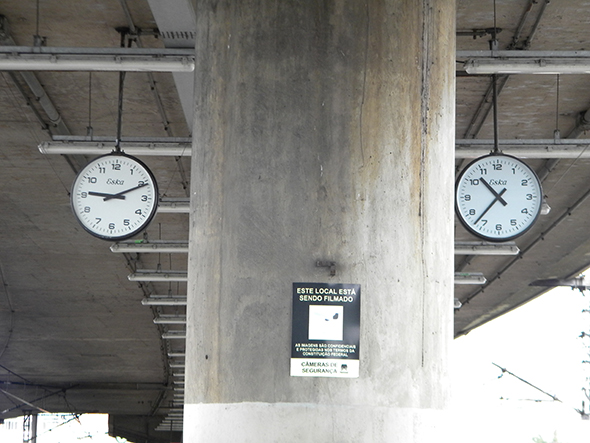
Lab The measure of a river: Mediation as the spring of the source. 9th Mercosul Biennial | Porto Alegre. Trensurb. July 2013. Photo Juliano Gomes
A Web Full of Knots and Us1 : The Sense of Public in the Forming of Mediators at the Mercosul Biennial
Diana Kolker
The mediator has become a familiar figure to gauchos – the ethnic moniker referring to people from Brazil’s southern state of Rio Grande do Sul. The mediator’s function may not be clear to some, but we can count on his/her availability for a conversation in an exhibition. Looking at the figures released by the Mercosul Biennial Foundation, headquartered in the state’s capital of Porto Alegre, it’s easy to endorse my statement.2 Nine editions of the event clocked over 5.014.707 visits to exhibitions and 1.229.460 mediated group visits. That said, it’s important to open a parentheses here: (however careful institutional accounting of the public attending their activities may be – knowing that institutions and their sponsors are especially interested in such quantitative data – these accounts will never reach the true number of those involved, nor the depth of engagement and its affects on bodies, bones and hearts.) Close parentheses. Now another number: during this time period over 1.769 people participated in mediator training courses offered by the Mercosul Biennial. This means that a significant body of people active (or not) in the artistic and educational fields of the region had the experience of being a mediator in one or more of the Mercosul Biennials and from that experience assumed different roles within available institutional functions (mediation, supervision, production, assembly, coordination, curators, etc.) and other cultural and educational spaces in the region.
Over the course of the Mercosul Biennial’s nine editions, the relationship with the public and the mediator’s role were discussed, transformed and expanded. The mediator training courses became such a key program that they earned more time in the institutional calendar than the exhibition itself. Mônica Hoff, former coordinator of the Mercosul Biennial pedagogic project, identified some critical milestones in the history of the Biennial, which led to its recognition as an educational institution, especially with respect to its dedication to the local public, the main access point of which was the mediator training courses.3 According to artist and critic Luiz Camnitzer, the first education curator of the event, the Biennial is a permanent institution dedicated to education and art, whose exhibition is only part of ongoing pedagogical research.4 However, at the end of the exhibition, the pedagogical project team, which comprises approximately 200 people, comes to an end.5 So how does this permanence of pedagogical research continue? Would it be possible to say that a school of mediation was established in the Mercosul Biennial? If so, what is the sense of publicness of this school? Maybe we can talk about a gaseous school that condenses with each edition of the Biennial to, in turn, evaporate when the exhibition ends? Although I may run the risk here of affirming that this school was formed less by an institutional direction than by the engagement of these educators who, after each biennial, returned home, as mediators, supervisors, producers, coordinators, lecturers, curators, or the general public.
Nets Are Webs of the Most Diverse Materials that Are Found in Knots/Us
“If it falls into the net, it’s a fish!” the popular saying goes. However, nowadays the word “net” covers a broader range of meanings than traditional fishing nets or even the beautiful hammocks we relax in, so characteristic of the Amerindian peoples (n.t. rede in Portuguese = net, hammock, web, network). Contemporary networks also articulate immaterial interconnections. We talk about networks of communication, of production, of services, of capital. According to the health researchers Regina Benevides and Eduardo Passos, network imagery involves what they call hot and cold modalities. Cold are the hyper-connective networks of neoliberalism investing in the homogenization of material and subjective production. Hot, as they define them, are the networks whose connectivity (or knots in the web) generate differentiation and therefore, resistance to the forces of the cold neoliberal web: “It is in this sense, that the experience of the collective, of the public or even the multitude should be taken up as a plan to produce new forms of existence that resist the forms of equalization or serialization of capitalism”6. Amidst this “hot” network the pedagogical project of the 9th Mercosul Biennial was gestated and designed, taking the form of a broadly integrated and distributed “net” conceived within its Cloud Formations program: experimental and micropolitical, it was the fruit of the desire to promote encounters, celebrate differences, disrupt, affect, and generate affection.
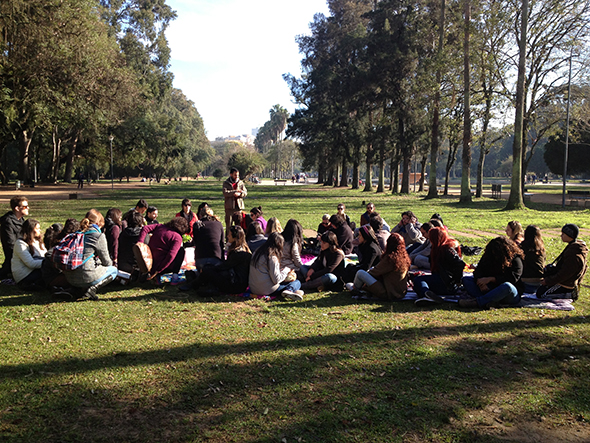
Lab Close to the ground: the invention of mediation. Coordinated by Jorge Menna Barreto. Farroupilha Park, Porto Alegre, July 2013. Photo Juliana Peppl.
If in previous years the pedagogical project sought to prepare mediators to offer the public a meaningful experience with the exhibition, for the 9th edition the boundaries between public and mediator, education and art were dissolved. Although some activities were designed for a specific group, all were open to whoever wished to participate. Curiosity was the only prerequisite. Thus, it would be more appropriate to speak about activities with rather than for the public. The activities of Cloud Formations were not in the service of some previous experience. They were in and of themselves an experience. In the words of Mônica Hoff:
I am not interested in instrumentalizing to create a rhetoric about works of art or about spaces, but what interests me is to discuss and experience the political field of this. And how much this changes the way we position ourselves in the world.”7
Undergraduates in their third year of studies and upwards and/or professionals of all backgrounds were eligible to participate in the training and subsequently act as mediators. We were able to count on people from the arts, pedagogy, philosophy, biology, architecture, museum studies, psychology, social sciences, history, communication, design, agronomy, and astronomy. Without a doubt this openness to all disciplines created an impact on the discourses about the exhibition and conferred a sense of legitimacy for the people who did not have visual arts training to talk about art. Maria Soledad, who acted as mediator on the 9th Mercosul Biennial, confirmed this: “I haven’t had any training in art and my first formal contact with art work has been the mediator training and my work as a mediator for the 9th Biennial. So in that sense I feel close to the public perspective”8. According to Mônica Hoff, the opening up of the mediator course for students from different areas was particularly due to the notion that the mediators were in fact the first public of the Mercosul Biennial9:
And when I think of the public or that word in the context of the public sphere or the public as this constructed entity, I think mostly about this figure of the mediator, as a means to see in this role perhaps a kind of intersection or in order to not see a differentiation between the public outside the institution and the public inside the institution.”10
All those involved in the artistic and educational processes of the Cloud Formations initiative already had their own experiences with education – whether as educators or learners at school or university, in museums, the Biennial itself, or in the community. So everyone came primed with a certain system of representation that had shaped us according to the perceptual codes, modes of relation and production within which we are immersed from childhood. According to Felix Guattari, any kind of educational project “immediately creates a whole series of micropolitical problems”11. Among these we could include the paradoxes related to the financing of major cultural events and the place occupied by educational projects associated with them. Despite the heat of the hot networks being at times swallowed by the coldness of the neoliberal network within which institutions make their way and align themselves, the reverse is also true. Perhaps one of the major effects of this experience was to produce cracks in some of the beams supporting the architecture of the relationships within which we have been shaped. To do this, it was necessary to break the walls of the institution, win over the city, affect bodies, put our feet on the terrain of the encounter. Artist Ricardo Basbaum tell us:
The term terrain is used here without any religious or mystical sense, but as a reference to a multiple and plural space, open to exchange, transformation, conversation, celebration, narrative games, historical references, etc., being crisscrossed by rhythms, beats and strong sense of corporeality.”12
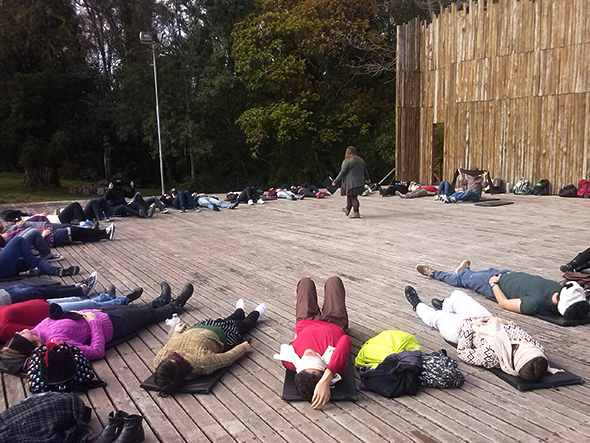
Lab. A shrub in the valley: mediation where it apparently is not. Coordinated by Helena Mouschoutis, Federico Testa and Potira Preiss. Botanical Gardens, Porto Alegre, august 2013. Photo Diana Kolker.
Our terrains of encounters were numerous and took concrete form through activities including Mediation Labs, Schools Residences13, Lectures, and an experience called Pollen Moment.14 Mediation Labs were experimental encounters articulating an expanded exercise of mediation with the experience/creation of poetic practices. The labs did not have the goal of creating models for the mediation of art, but rather that of promoting the art of encounter that Brazilian song writer Vinicius de Moraes sings about15 – encounters with educators, artists, artworks, cultures, streets, texts, technicians, scientists, children, researchers, policy, city, institutions, activists, concepts, and so on. In the words of educator and researcher Helena Mouschoutis:
Within an encounter the experience can be very profound and go beyond artworks, concepts and even the exhibition walls. It is a moment of exchange between people, bodies, lives, and experiences. The experiences we share are mixed with each other and for this reason no other device of mediation within curatorial projects can replace the human factor that a mediator can bring. It’s due to the potentiating action of the experience of the artistic mediator that a group comes together and shares experiences and sensations, creating a bond, making associations, opening themselves up to the encounter.”16
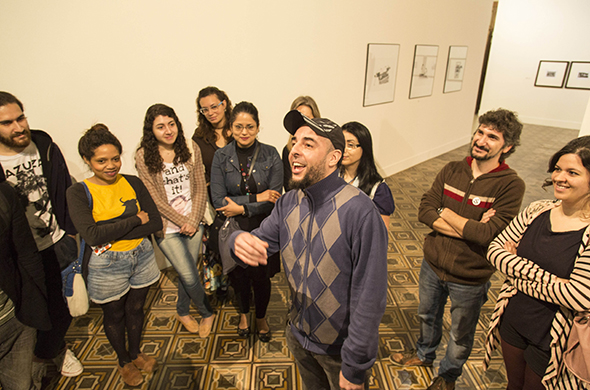
Lab Celestial Arc: the refractive idea in mediation. Coordinated by Luciano Montanha and Roger Kichalowsky. MARGS, Porto Alegre july 2013. Photo Cristiano Sant’ana.
Held weekly, each laboratory was coordinated by one or more invitees. The labs were presents (in every possible meaning of the word). And like any good present each was preceded with an aura of mystery and surprise. Their titles17 were poetic enigmas accompanied by small provocative texts that interconnected poetic and pedagogical practices with the themes of the 9th Mercosul Biennial, whose title Weather Permitting pointed to how the political, historic, and meteorological climate affects us individually and collectively.18 From this material the invitees created their proposals and chose a particular space in the city in which to present them. We conducted Labs in art and technology museums, but also in the botanical garden, at the edge of the Guaiba River estuary, in the Customs Square, at train stations, in the park, at a school for early childhood education, and in a terrible basement of a house formerly used as a detention center during the military dictatorship. These locations were experimented in, occupied and reinvented as proposed by our invitees and participants’ involvement.
More than a gaseous school, we were interested in processes of un-learning, or de-schooling, recalling the radical educator and philosopher, Ivan Illich.19 Everything was a potential intercessor: the proponents of each Lab, the other mediators (from different disciplines and backgrounds), the curious public, the pedagogic team, the teachers, the locales where each activity took place, the artists, and the works of art. In this way, we sought to break down the pedagogical architecture that employs vertical training processes and, as Rancière writes, establish a “structuring fiction in the explanatory conception of the world”20. It fell to me to establish a form of superlistening that would orient the activation of potencies and the transformation of individual and collective fragilities toward an invention of self; taking care to follow the first principle of psychoanalysis recommended by Guattari: “Don’t get in the way”21. It did not interest us to establish a mediator model or exercise mediation strategies to be reproduced with the public. What interested us was the multiple and the singular in each encounter. We were interest in facilitating good encounters. We were interested in encouraging autonomy. We were interested in seeing the mediators appropriate the events of each lab in the most potent of ways. We were interested in shaping a path as a collective body simultaneously with the creation of individual paths and thinking about the shaping process of the path itself.
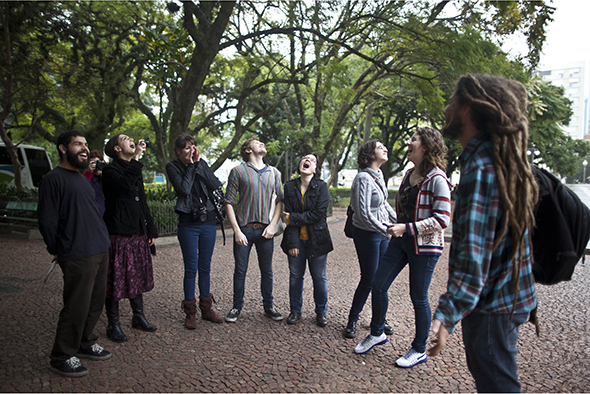
Lab El Nino/La Nina: The atmospheric phenomena and climate conditions in the context of mediation. The city center, Porto Alegre. June 2013. Photo: Eduardo Seidl
In El Nino lab/La Nina: The atmospheric phenomena and climate conditions in the context of mediation, coordinated by curator/educator Valquíria Prates, the natural phenomenon was the trigger for thinking about the unpredictability of the field inherent to the practice of art mediation:
El Niño and La Niña are opposite atmospheric phenomena. If the abnormal warming of the surface waters of the Pacific Ocean causes the first, the second is due to the reverse process, the abnormal cooling. The arrival of both does not require change or impact just one region of the planet, but as a whole, in distinct and simultaneous forms, occurring many times. Climate change and atmospheric phenomena are brought to this lab as a metaphor to discuss the field of unpredictability regarding the relationship between education and art through mediation. We are interested in dialogue about what is not obvious in mediation discourse – in the possible chance happening and the improbable occurrence that happens when diametrically opposed air masses (school/museum, educational and artistic methodologies) encounter one another, the kind of shocks produced there and how they behave and dialogue with one another.”22
Responding to Valquíra Prates’ proposal, mediators presented instructional works by the artists Yoko Ono and Marjetica Potrč engaging the people transiting in, through and out of the public areas of downtown Porto Alegre. Afterwards the groups gathered to talk and discuss the issues that emerged from the experience. Direct contact with the public, the exercise to persuade passers-by to participate in an artistic proposition, the experience of simultaneously effecting a mediation and an artistic event, and the difference between the action that was planned and what actually happened raised questions that were familiar to the mediators’ practice in the context of an art exhibition: How to deal with the characteristic unpredictability of the relationship between the public and art? Can there be a wrong when there is no right? When we use the word climate in the context of mediation in art, what meanings and signification could this word have? What elements and bodies orbit the field of art? How are they attracted and repelled? What types of weathers are exposed?
“How could a mediation be a river?” This question closed out the text announcing the Lab The measure of a river: Mediation as the spring of the source, coordinated by the curators/educators Jessica Gogan and Luiz Guilherme Vergara. In this experience we interfered in the flow, not of water, but of people. The lab was carried out on metro trains and at train stations that transformed themselves into poetic platforms, even (or especially) for those using the transport daily. The participants received a piece of paper with short instructions that included various orientations such as: breathe, drift, observe, welcome, give something, make an inventory of your perceptions and ideas, “converse with possible (i)mediations: poetic, ethnographic, journalistic and affective presents”. Armed with tools such as paper, pencils, cameras, eyes, ears, noses, skin, and feet to collect and register the world about us, the mediators wandered in and out of the wagons. Some unsuspecting passengers embarked on the train/metaphor with us and ended up being captured by an intoxication that took in all of us. As Renata Siegmann reports:
If metaphor means transport in Greek, what then would be a metaphor within a metaphor? […] Following the idea of what flows and what is fixed, we decided to provoke passengers, injecting a spark of questioning. We got into the wagon and instead of sitting or choosing a place to stand, we frantically walked around without stopping and when the doors opened at the next station, got off the train and then stopped, letting people enter and leave. We stopped when others moved and we moved when everyone was still. At the end of the lab the groups presented their experiments and each one was completely different from the other. I could understand the role of the mediator very clearly: Be a provocateur that cedes autonomy to the other to experiment according to their own repertoire. Inspire curiosity, raise questions, invite people to play at being a world explorer, through art.”23
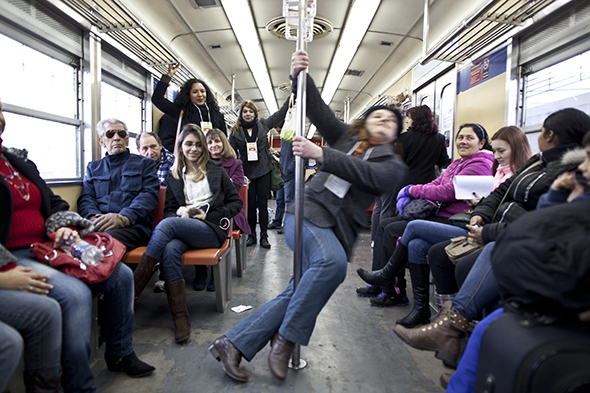
Lab The measure of a river: Mediation as the spring of the source. 9th Mercosul Biennial | Porto Alegre. Trensurb. July 2013. Photo: Eduardo Seidl
According to philosopher Rosa Dias, this state of intoxication happens when we are triggered by events that affect us, that move us. We are then flooded with a force that makes us feel more alive, more full, more present. “The moment we feel touched by something and our animal being responds to this provocation, we produce the aesthetic state – the one in which we transfigure things.”24 Juliano Gomes, professor of philosophy and mediator in the 9th Mercosul Biennial, a regular train user as a means of transport from his home to work, recounted that the experience enabled him to turn his gaze to that which eluded him in his day-to-day utilitarian relationship with transport.25 A small intervention in the daily flow of life may open the door to the extraordinary, producing breaks in the fabric of time, breaking with normative logic, introducing a state of art, mobilizing presence, mobilizing presents.
As we can see in Renata’s statement, at the end of the experience she could “understand the mediator’s role very clearly”. However, this beautiful definition was not explained or transmitted. Renata lived the experience allowing herself to be affected and to produce her own thinking about it. One can perceive here an ethics and aesthetics key to the training of the mediators. The concepts, practices, and strategies were not explained, but lived in the very process of formation. Rancière intones: “Who teaches without liberating, oppresses. And who emancipates does not have to worry about what the emancipated must learn. He’ll learn what he wants, nothing, maybe”26.
If the school environment, in particular, initiates us into the explicative order of the world, shaping us to conform to dominant modes of relating, appropriately, it was to a school context to which we turned for the Lab Not all responses fit an adult: A mediation of and by children. We broke with the age hierarchy, proposing that children between the ages of 4 and 8 years old of Escola Amigos do Verde (Green Friends School) coordinate the laboratory. Undoubtedly, it was one of the most emotional laboratories, prompting happy tears. The activities planned and led by the children included a visit mediated by them to the school environment, where they generously shared their hiding places, their favorite places, their great stories, and participation in a series of games that involved hugs, songs, affection, and lots of laughter.
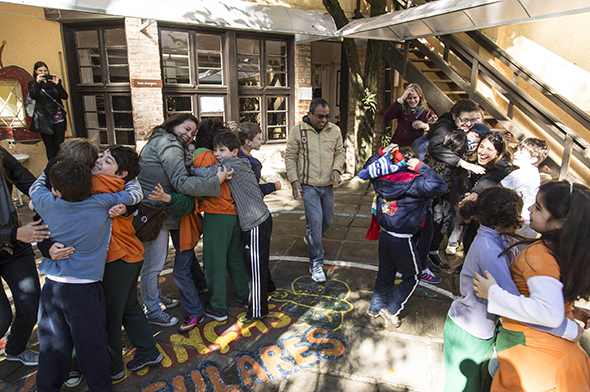
Lab Not all responses fit in an adult: A mediation for and by children. Friends of the Green School. Porto Alegre, September 2014. Photo: Cristiano Sant’Anna.
“When considering the context of mediation, what are we are talking about when we refer to the underground, subcutaneous, substrate, sub intended? What are the basements and isolated and submerged compartments of mediation?” These were some of the provocative questions that emerged with the Lab The basement of mediation, coordinated by the researcher Cayo Honorato. This experience contained so many layers that an archaeological excavation would be necessary to think about them. The Lab debated, among other issues, the mediators’ perceptions about their work and what the hiring institutions expect and want from them. In the basement we mapped the mediators’ moral genealogy. The laboratory was held in the basement of the Institute of Brazilian Architects (IAB), in a house whose sinister history included a period working under the Department of Political and Social Order (DOPS). In the 1960s and 70s, a period marked by military civilian dictatorship, the space was used by the repressive forces of the state to torture and murder political prisoners who were opposed to the regime. Another layer present in the laboratory, not coincidentally, was the impact of effects caused by physical space.
The lab made me extremely uncomfortable and that’s unusual. (…) Then I thought to myself, I remembered that art can cause this malaise. What I hadn’t realized was that the basement is this, this dark space, this angst, lack of air, that mediation can bring if not well managed, made clear, or any other time when we ourselves are the basement of mediation…”27
Often the body’s relationship to the architecture in which an exhibition is presented is underground to mediation practices, but it by no means produces smaller effects. The experience was significant to bring up this fundamental instance of the relationship with art. There was also a strong intersection with contemporary context in which the lab was held. Happening in the midst of a week of intense protests in the streets of Brazil’s cities with news of violent repression by the military police, the protests and their issues were brought up many times by the mediators during the laboratory. The physical presence in that space stained by a terrible memory made it extremely important to think about the crisscrossing, ruptures and continuities of this history in the present.
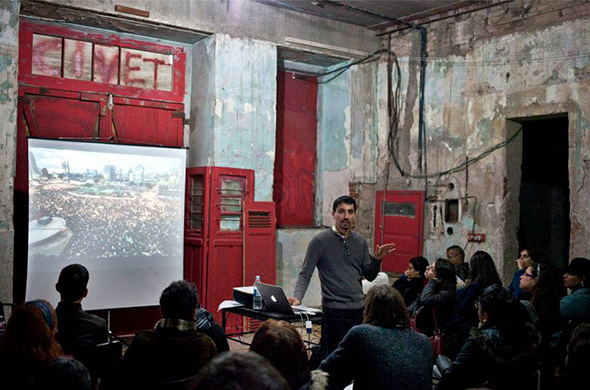
Lab. The basement of the mediation. Basement of the Institute of Brazilian Architects (IAB), Porto Alegre, June 2013. Photo: Eduardo Seidl
These mediators came together as a passionate and committed team creating connections with the public and with the artworks. I dare say that never have the mediators been so imbued with a political sense of their role and so connected with the meaning of the public as they were in this edition of the Biennial. However, it would be wrong to reduce the analysis of these events to causes and effects, nor to only associate them with the training of mediators. Among other factors that unfortunately we will not touch upon in this essay, one also cannot separate the 9th Mercosul Biennial from its context. A year marked by intense protests on the streets of so many cities throughout the country and in virtual spaces could not be passed by in a neutral way. Discussions about mobility, accessibility and guaranteed equalities and basic rights were heard via the Biennial’s public, but especially, via their first public: the mediators. Themes were debated and re-vindicated such as the professionalization of mediation, working conditions for educators, the relationship of privilege in the field of visual arts, and the financing of cultural events in diverse regions of the country. The participation of social networks in this process was also significant. The mediators communicated and disseminated their impressions in real time -opinions, experiences, and thoughts – involving in this way an extra institutional public in the discussions and expanding the debates beyond the frontiers of Rio Grande do Sul. In the words of mediator Maria Soledad:
The encounters in various places in the city (on the train, in the former clandestine detention center of political prisoners, in the park, in the city center…) in closed and open spaces, profoundly political and oriented toward the public, with appearance of “the little do with art”, paradoxically favored a specific reflection on our practice, on our potential as mediators, including our own tools for the act of mediating. As intense as the program, the affection was not personal sentimentality, but poetic and political content; didactic and methodical. The proposal was of affections. The pedagogical proposal seemed to me in itself, poetical and political: aesthetically rich, provoking sentiments, thoughts, attitudes, scandals and terrors, questions, searches, knowledge, exchange and ethical movements of all kinds. That’s what I think poetry and politics is.”28
I conclude this text with the certainly of its insufficiency. So I will use these last few lines to justify why I appropriated the title of the project Publicness in Art, substituting “art” for “forming of the mediators”. According to Basbaum, “what the artist looks to build is the invisible welcoming space, protecting a specific area that transmutes itself gradually into a provocative region of encounters”29. It was with this same desire that the mediator training of the 9th Biennial was conceived. We sought to foment encounters, hoping that these would augment the potencies of thought, action, affect the time, and invent worlds. A welcoming network whose threads are in us.
_
1 Translator’s note: In Portuguese “nós” means “us” but also “knots” – in this sense the “nós” suggests the mediators themselves, the process of creating a network as one of creating knots (affective, social, political, poetic), and the encounters experienced throughout the laboratory program and, in turn, as mediators with diverse publics and within different socio-cultural contexts as a kind of encounter-human being-knot.
2 Social Responsibility Report of the 9th Mercosul Biennial. Available: http://www.fundacaobienal.art.br/site/files/responsabilidade-social/relatorio-9a-bienal-responsabilidade-social.pdf
3 Mônica Hoff. “Mediação (da arte) e Curadoria (educativa) na Bienal do Mercosul, ou a arte onde ela ‘aparentemente’ não está.” São Paulo: Trama Interdisciplinar- v.4-n.1- 2013.
4 Luiz Camnitzer and Gabriel Pérez-Barreiro. Eds. Educação para a arte/Arte para a educação. Porto Alegre 6a Bienal do Mercosul, 2009.
5 Beginning only with the 6th Biennial the institution assumed a permanent position of pedagogic coordinator and an invited education curator for each edition. Currently, the curatorial project for the 10th edition, publicly announced on August 26, 2014, did not include a pedagogical curator.
6 Regina Benevides and Eduardo Passos. “Clínica, política e as modulações do capitalismo”. Lugar Comum. Nº 19-20, p 159-171.
7 Mônica Hoff. Video statement made for the project Publicness in Art.
8 Maria Soledad Mendez. Video statement made for the project Publicness in Art.
9 The opening of the mediator training course to students from diverse disciplines and backgrounds happened for the first time with the 5th edition of the Biennial.
10 Op cit. Statement Mônica Hoff.
11 Félix Guattari. Revolução Molecular: pulsações políticas do desejo. SP: Editora Brasiliense, 1985.
12 Ricardo Basbaum. “Quem é que vê nossos trabalhos?” Seminários Internacionais Museu Vale 2009 – Criação e Crítica (2009), p.202. Available: http://www.seminariosmv.org.br/2009/textos/13_ricardo.pdf (Accessed December 2015)
13 Program included as part of the training course and held in public schools of Porto Alegre comprised of a class observation period (which could be from preschool to adult education) and subsequently conducting a workshop whose theme was related to issues raised by the curatorial proposal for each Biennial.
14 Pollen Moment comprised a short residency in a location where the organization and/or context was engaging with a form of activity distinctly different from the day-to-day participants’ routines or practices. In all, 20 partner institutions welcomed the proposal, including universities, museums, NGOs, community cultural centers, foundations, sites with proposals for agro-ecological care, recycling spaces, etc. Immersion in these spaces was a call for poetic production with the encounter with the different.
15 “A vida é a arte do encontro, embora haja tanto desencontro pela vida” (Life is the art of encounter, even though there are so many mis-encounters with life). Samba da benção, Vinícius de Moraes.
16 Helena dos Santos Moschoutis. “Pela lei natural dos encontros. Experiências de mediação artística no espaço expositivo e na sala de aula”. Pelotas: UFPEL, 2013
17 The titles of the labs were in chronological order: The climate of mediation, mediation and different worldviews; El Niño / La Niña: atmospheric phenomena and climate conditions in the context of mediation; The basement of the mediation; From the Milky Way to tiny detail: the mediation of macro the micro (and vice versa); Celestial Arc: the refractive idea in mediation, discovery and invention: mediation as poetic practice; The measure of a river: mediation as spring of the source; Close to the ground: the invention of mediation; Induced earthquakes: disasters in mediation; A shrub in the valley: mediation where (apparently) it is not; In practice, the theory is different: accessibility; Not all the answers fit in an adult: a mediation by and for children; In the non-beginning was the word: mediation as observation.
18 The 9th Mercosul Biennial, Weather Permitting, the focus of artistic director Sofía Hernández Chong’s curatorial proposal was the interactions between nature and culture, experimentation and innovation. Including works and programs that addressed this and the way the artists explored that relationship. The exhibition also focused on how different atmospheric disturbances affect our experience and perceptions we have of the world around us.
19 Ivan Ilich. Sociedade sem escolas. RJ: Editora Vozes, 1985.
20 Jacques Rancière. O mestre ignorante. SP: Editora Autêntica, 2011.
21 Guattari. Op.Cit., p.139.
22 Text sent to Valquíria Prates as a creative stimulus to develop the lab El Niño/La Niña: Atmospheric phenomena and the climatic conditions of mediation
23 Personal communication, February 23, 2015.
24 Rosa Dias. Nietzsche, vida como obra de arte. Rio de Janeiro: Civilização Brasileira, 2011, p. 68,69
25 Personal communication, February 18th, 2015
26 Rancière. Op.Cit., p.37
27 Statement by Vagner Rampinini, mediator and assistant supervisor for the 9th Mercosul Biennial’s distance learning platform, made during the mediator training.
28 Personal communication, February 18th, 2015
29 Basbaum. Op.Cit, p 202.



